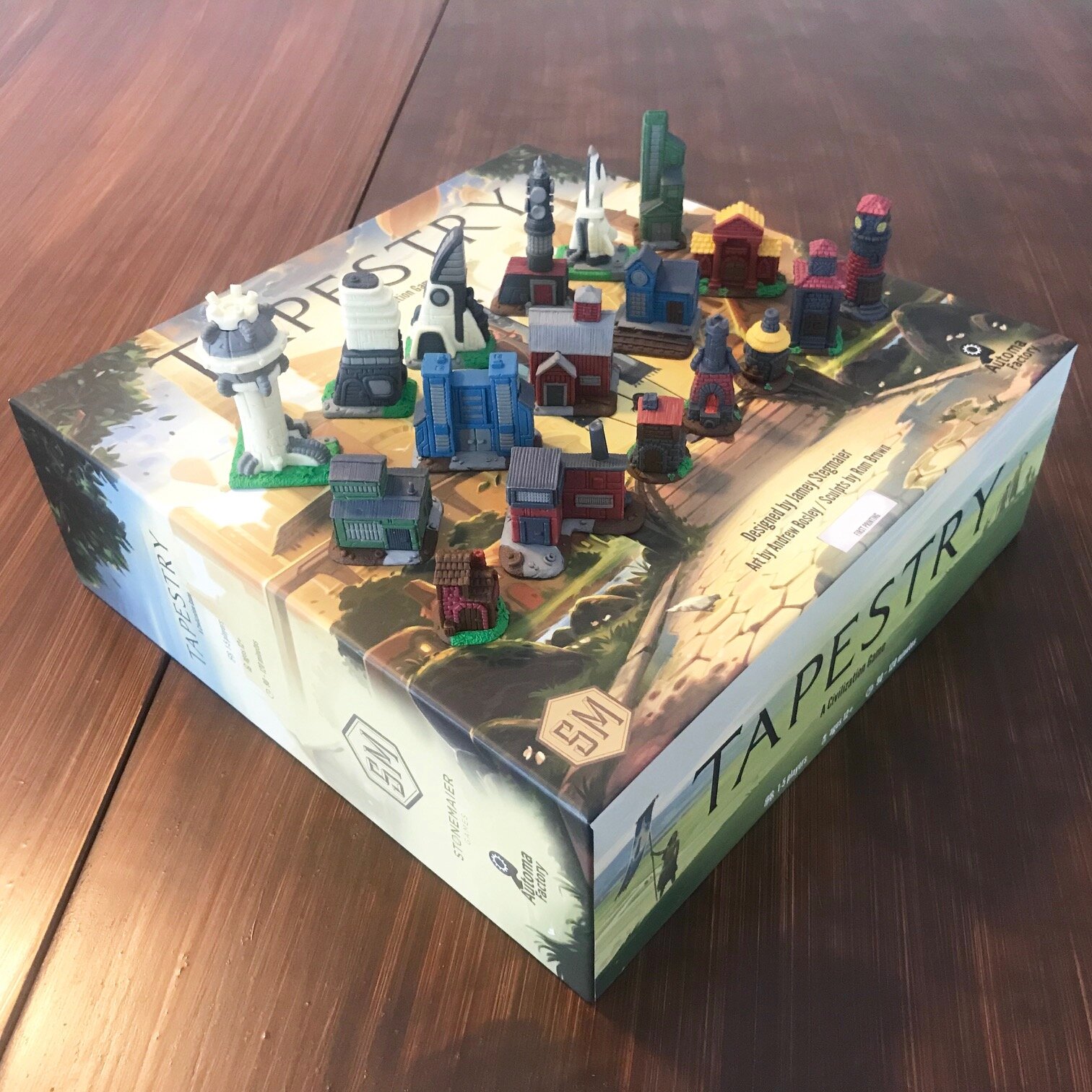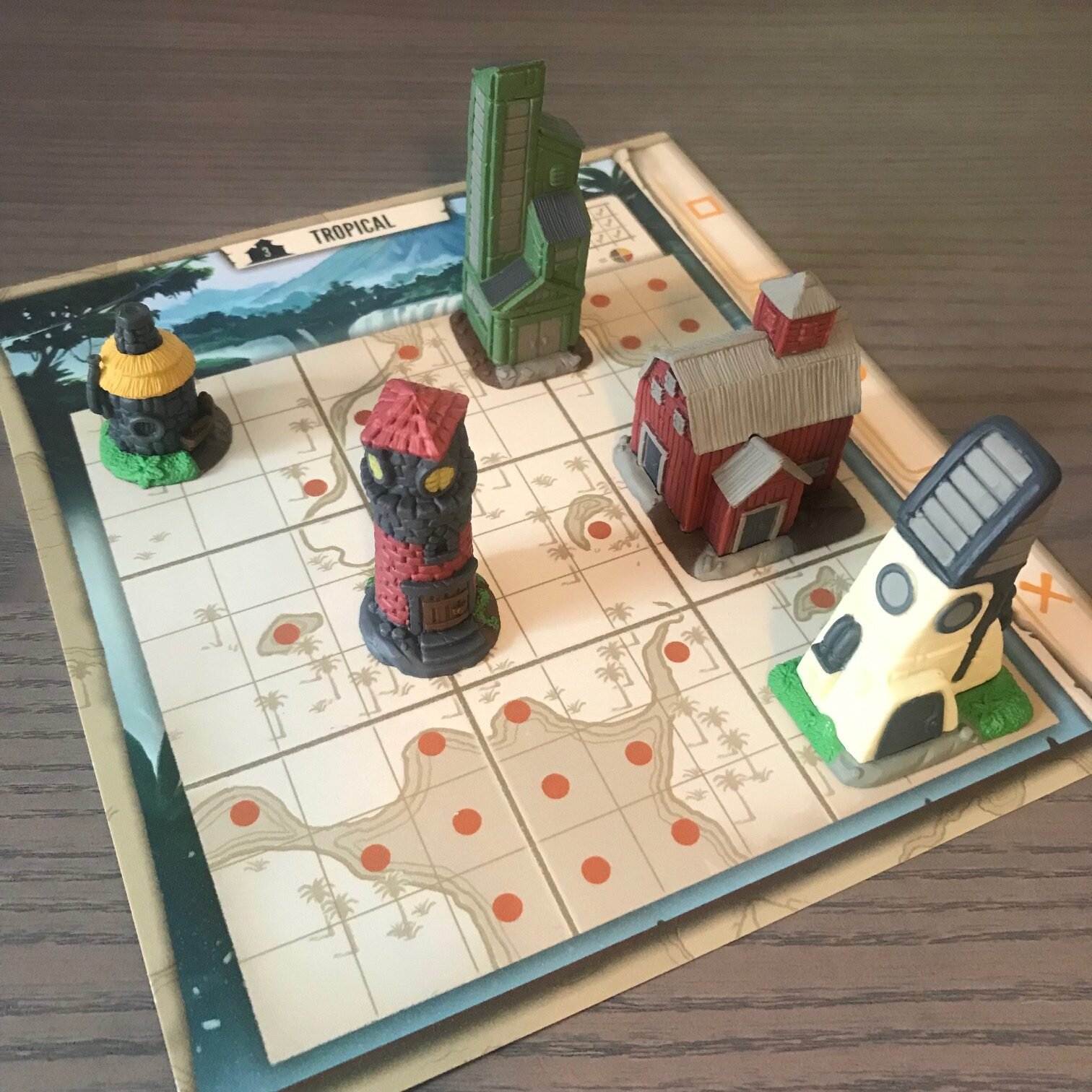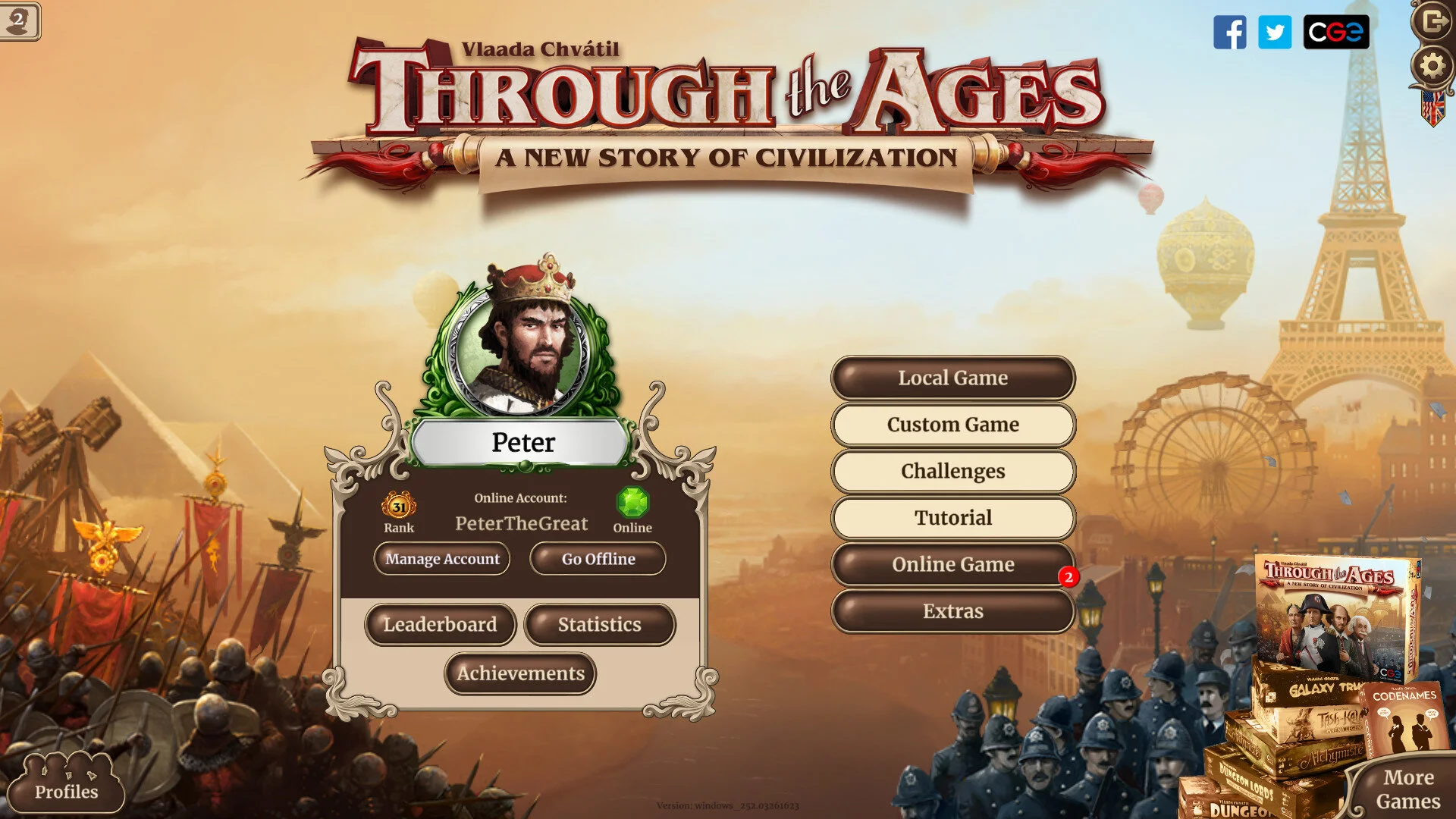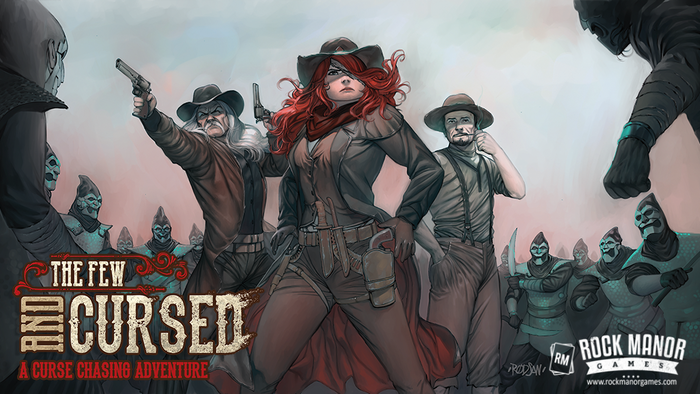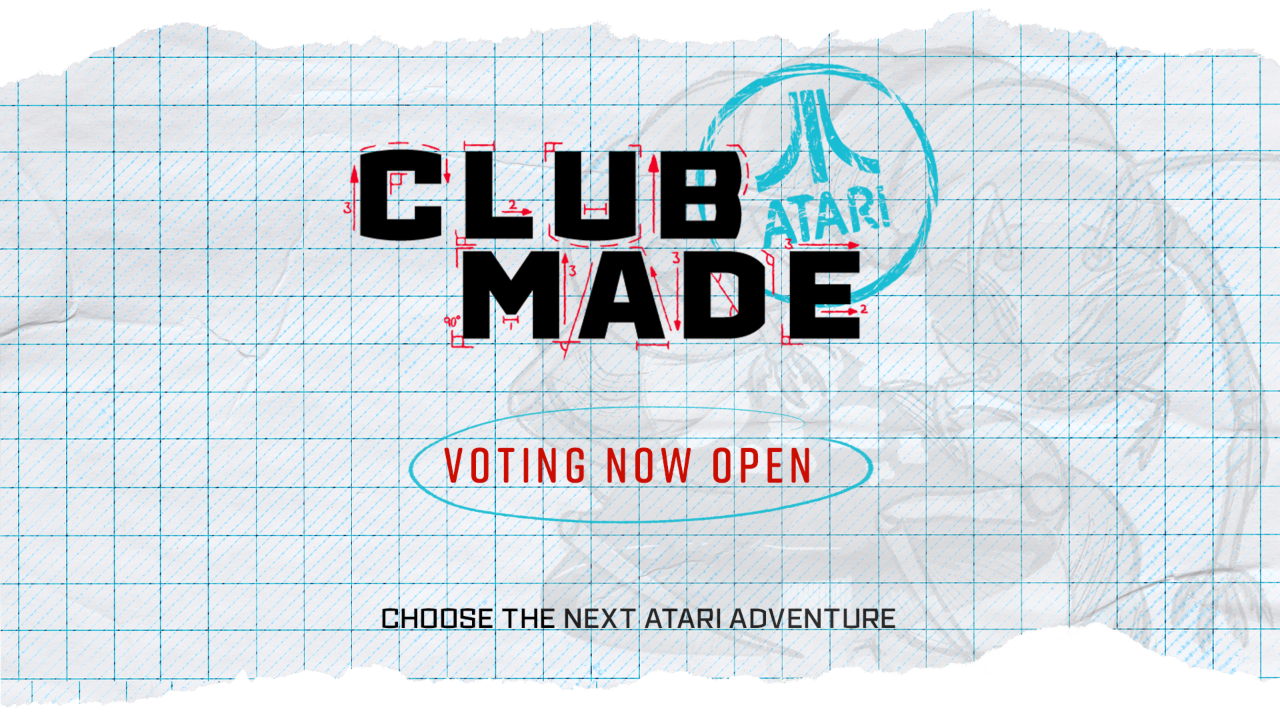Review copy provided by Stonemaier Games
Jamey Stegmaier is a board game designer who published Viticulture in 2011 via Kickstarter, but he, and his company, exploded in popularity five years later when he designed Scythe, which captured the hearts and wallets of many tabletop fans. His games are very well-received, and his most recent big-box strategy game is Tapestry, which released in 2018 and has been bolstered by the Plans & Ploys expansion from this year.
Tapestry was designed solely by Jamey, but it was brought to life by the artwork of Andrew Bosley and the sculpting work of Rom Brown. It’s a competitive civ-building board game that features asymmetric civilizations, gorgeous miniatures, and medium-weight complexity.
Depending on the player count, it’ll take between two and three hours to play, but it supports anywhere from 1 to 5 players.
From humble beginnings, players will advance in science, technology, exploration, and military conquest in order to build a larger, more defined civilization. The further a civilization progresses, the stronger and more resourceful they become, expanding their capital city and elevating their status around the world.
It’s a game of expansion and choice. You decide what happens to your people.
STORY
A civilization is nothing without the record of its existence, the efforts of its people, and the stories of its rise to power. To create a civilization that will endure, innovation must never stop, exploration must persist, rivals must be fought off, and the search for knowledge must push forward without inhibition. These are the foundations of every prominent civilization. Every story is different. So how will you write yours?
The premise of every civ-building game is intoxicating. Tell the story of a people from start to finish. Begin with nothing and end with the realization of a grand vision for the civilization.
It’s why PC games like Age of Empires, Total War, and Civilization have always been popular. On a micro-scale, it’s why The Sims is such an enduring franchise. Starting with fresh clay and molding something spectacular out of the waiting lump is appealing. Creation excites us. Makes us want to give it a go.
And Tapestry fulfills that innate desire with aplomb.
GAMEPLAY
While this game is a medium-weight experience for most tabletop gamers, the complexity lies not in the actions but in the resolution of those actions.
Because there are only two actions in the game, explained thoroughly in a four-page rulebook. Yes, there are only four pages to the rulebook. It is an amazing feat that makes me really appreciate the game design. I can’t remember the last time I read a rulebook this small. For anything, let alone a heavier strategy game.
Before you get to that, though, setup may take a little bit of time. The integrated variability of the game means that players make choices that will slow down the process before you can play. Choosing a civilization. Selecting a capital city mat. Once those choices are made, you still have to hand out all of the Income miniatures, Outpost tokens, and player tokens before setting up the Landmark miniatures, the cards, and all of the other game components.
It takes some time.
Get past that, though, and you only ever have two choices—collect income or progress on an advancement track. Collecting income follows predetermined steps during which the civilization abilities can activate, Tapestry cards can be played, technology can be upgraded, victory points collected, and resources gathered. Alternatively, advancing on a track involves paying the required resources and then resolving the action of whatever space you’ve reached on either the science, technology, exploration, or military tracks.
These actions take place within the “eras” of your civilization. During each era, you will advance on different tracks until you have no more resources to expend or until you want to move forward for other reasons. Then you will collect your income. That signals the end of one era and the beginning of another. This continues until all players have completed their fifth era and scored all relevant victory points.
I love the simplicity of Tapestry. There are a lot of icons to decipher and the relationships between your civilization, your capital city, and your advancement tracks are important, but the overall choices are simple. Advance on a certain track or start a new era.
There’s a simple formula here of Simplicity + Variability = Depth. The game plays smoothly, for passionate gamers and newcomers alike, but the sheer number of possibilities give this game some long legs. Like the wearing stilts kind of long legs. More than a dozen asymmetric civilizations provide players with unique scoring and strategic options during any game. The capital city mats, four advancement tracks, Landmark miniatures, Tapestry cards, technology cards, and other variable components give even more flexibility to the experience.
I do think that some civilizations are better than others, and a couple of the advancement tracks seem stronger, but there is a substantial balance here from the pre-existing gameplay mechanics and from post-release adjustments published by Stonemaier Games.
And part of what I think makes Tapestry such a successful game is the manner in which it creates the competitive tabletop play. Yes, you can conquer other players’ territory. You can push with aggression toward their space or cut them off. But that’s a smaller aspect of the game. Most of the competition is indirect as players pursue their own civilization’s agendas in parallel to each other. One player progresses on the Exploration track and makes it to space before another. Or maybe a player builds a coveted Landmark just before another player can reach that spot. It’s a more peaceful conflict, if that makes any sense.
In the games I played, the losing players just acknowledged the smart plays and well-oiled civilization that the winning player accomplished. It’s less “losing” and more “winning less” in my eyes.
Where the game does slow down is in the waiting for other players’ turns. Sometimes, resolving an action can take some time as players determine which exact resources should be used, which tiles or cards to select, and other similar choices. Sometimes, the next player can just get started, but other times whatever happens might influence their decisions, so you have to wait.
It’s not a big criticism, as I enjoy talking with my wife and friends when I play games, but it does make a long game longer.
More the most part, though, Tapestry succeeds in creating a civ-building game that makes me want to experiment with different peoples, tracks, and decisions. There is so much to explore in the gameplay and I love how easy it is to play something so grand.
VISUALS
Do you remember in Toy Story when the aliens meet Buzz Lightyear, the stranger from the outside? Oooooohhhh.
How about that first sip of Coke? Ahhhhhh.
That pretty much sums up my experience opening Tapestry and getting all of the components out on the table. The civilization mats, player boards, and capital city mats are slick and sturdy. The double-sided board is massive. The small tech-tree buildings are chunky and detailed. The Landmarks are painted miniatures—painted, I do say! Everything about this game feels premium.
Pieces are lovely to hold. The components all feel like they will last a long time.
And I’ll always enjoy some art from Andrew Bosley, who worked on Everdell.
I’ll talk about the iconography more later on, but, from a visual perspective, the symbols are easily distinguishable and no two are alike in a way that would confuse players. The aesthetic of Tapestry is really clean, with soft neutral colors contrasted by deep blacks and bold primary colors. It’s pretty and it’s functional. Some games make the mistake of indulging in background illustrations and non-essential artwork at the detriment of visibility and gameplay, but Tapestry does not fall victim to that trend.
The game is a joy to place and the pieces are a joy to touch. Did I mention the painted miniatures? I’ll no longer be forced to question why I haven’t painted the flat gray mounds of plastic in front of me!
REPLAYABILITY
There is a lot of replay value here.
16 different civilizations. 6 unique capital city mats. 4 technology tracks. 18 landmarks. Over 70 cards, split between the Tapestry and Tech decks. And if you consider the newly-released Plans & Ploys expansion, there are an additional 10 civilizations, 7 landmarks, and 20 cards.
All of those variables create a stupid amount of replayability… with just the regular game mode. The Shadow Empire Variant can influence two-player games. And the Automa rears its foreboding tabletop head once again to challenge anyone who is looking for a solo game.
Some games are really designed for one particular player count, but Tapestry (and other Jamey Stegmaier designs) really makes a good argument for staying on the shelf. There are great ways to play from 1-5 players. No player count is left out in that range. And the content really supports a lot of time on the table.
WHAT IT COULD HAVE DONE BETTER
The main problem with Tapestry, for me, concerned the iconography. And this complaint will likely evaporate after several playthroughs, but it’s something that affects all games that heavily rely on icons to avoid the use of text whenever possible on the board.
All four technology tracks in the game have different symbols associated with them and for new players—those that haven’t ever played the game or those that have only played a few times—it can be disorienting and confusing to interpret the action spaces and what they mean. The first few games will likely involve players feverishly examining the reference sheets to understand what they’re doing at any point. It drastically slows down the game and makes a 2-hour game turn into a 4-hour game.
Once everyone knows how to play and understands what each symbol means, there isn’t much of a problem. But it’s a bigger hurdle to jump in the first few playthroughs.
Also, some of the civilizations didn’t seem as powerful as others, but Stonemaier Games does a good job of balancing the game post-release. There have already been three revised updates to the Civilizations Adjustment sheet, so that helps to tweak the gameplay toward a more fair experience.
A final (very minor) complaint involves the addition of plastic baggies. There are several in the box with the game components, but they are of one size and they don’t effectively separate out the components that don’t fit in the insert. So I had to use some of my own. Most players may not care at all about that, but I’m pretty particular about how I like to organize my games. An efficient organization can help to speed up both game setup and breakdown, so it’s important to me.
At the end of the day, though, Tapestry is better off than most games because Stonemaier Games is pretty transparent about improving their games and providing support. The inclusion of the Shadow Empire variant, the single-player Automa, the Civilization Adjustments, and other content speaks to that positive business perspective from Jamey and his team.
VERDICT
Tapestry reminds me of my experience with Scythe. The core mechanics are different, with civilization-building and technology tracks replacing the broader area control and encounter-based gameplay, but there is still a wonderfully diverse set of options in front of players and there is no one way to win the game.
Players can interact and, in some cases, conquer each other, but that doesn’t define the tabletop experience. This is not a small narrative window into the growth of an empire. This is the broad strokes of an entire civilization from the primitive use of fire to the advanced technologies that send humanity into space, the birth of AI, and other signifiers of the future.
No civilization will fail. All of them will complete the journey. It’s just a matter of who reaches furthest toward greatness.
Here’s what I love about Tapestry: a remarkable commitment to high-quality production and eye-catching game components; simplistic actions that support intricate technology tracks and variable player options; and competitive gameplay which avoids outright aggression and player elimination.
All of these elements weave together and create the fabric of a good game and a lovely time around the table.
If you’re interested in Tapestry or other exciting tabletop games, Stonemaier Games has a lot to offer.





